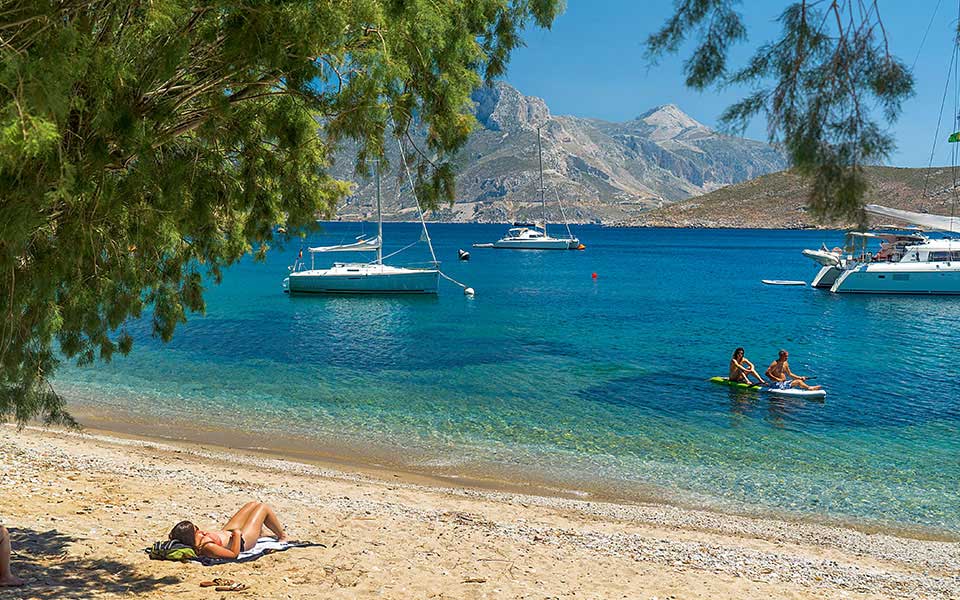Since the dawn of Greece Is, our mission has been to show Greece as it really is: multifarious, vibrant, a country of diverse nature and complex culture.
We’ve traveled from the very north, through the mountains of the mainland, to the tiniest islands in the south, and we’ve deep-dived into the cities and some of the most popular destinations, giving them our full attention in dedicated magazines.
We have covered many of our favorite destinations more than once, creating in-depth and off-the-beaten-path guides that help you get right to the good stuff.
But here we want to zoom out and provide a bird’s eye view – to help you choose from this incredible variety and find the perfect corner of paradise for you. In that spirit here are 40+ destinations, divided by region:
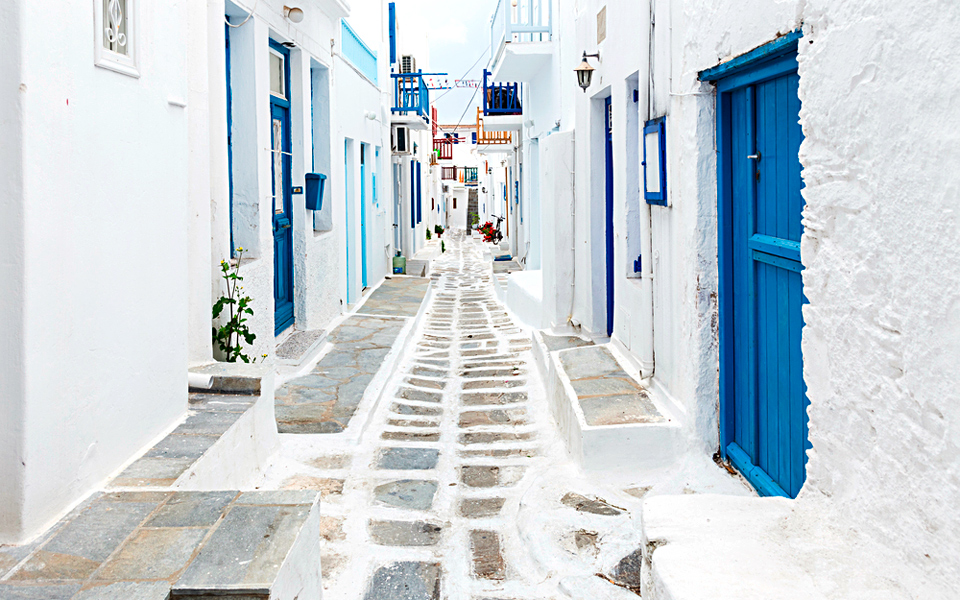
© Shutterstock
Cyclades
Picture a Greek island. What you imagine probably includes a myriad of sugar-cube-like houses with blue shutters. This architecture is typical of the Cycladic islands, which include some of the most famous Greek tourist destinations. Thirty-three islands comprise this island group, which lies in the heart of the Aegean. While each one has unique features, the group as a whole is mainly rocky and arid. However, the traditional fare is still made with delicious locally-produced vegetables, wild greens, and cheeses, as well as, of course, plenty of fresh fish and seafood (find out more here).
Besides these destinations below, you can find articles about other Cycladic islands through the search feature on our site (type: “Cyclades”).
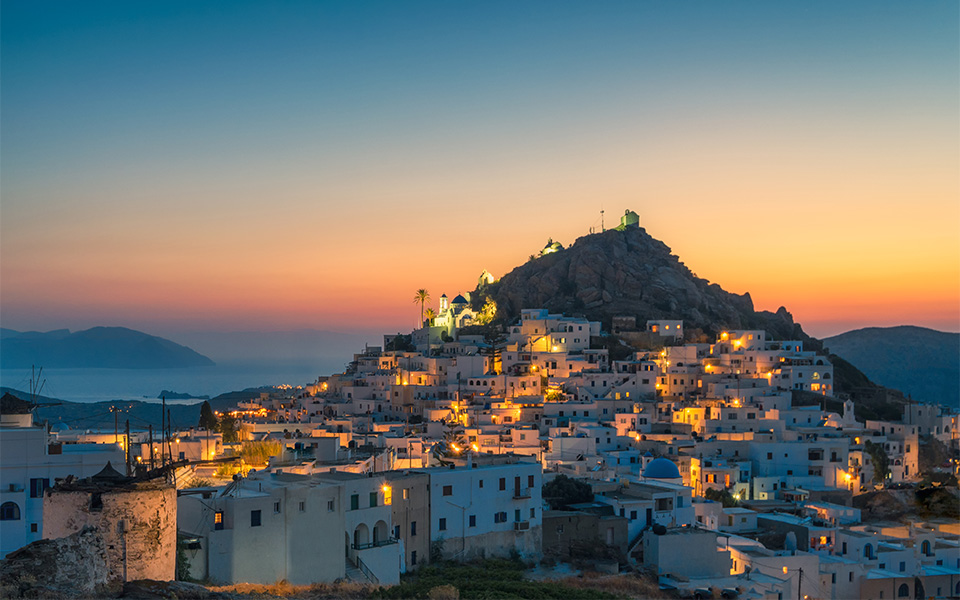
© Shutterstock
Ios
Best known for its bars, cocktails and pulsing music, Chora, the main town of Ios, is a great place for those used to partying all night, and those wanting to relive their youth. However, for those looking for some peace and quiet, there are also places on this island that provide tranquility and divine landscapes. Sightseeing should include visits to some of the many (rumored to be 365) churches, which adorn the island’s hills. Following the stone-paved path to Palaiokastro (the remains of a Byzantine fortress in the eastern part of the island), will grant you an unbelievable view of the silky sea.
Great For: bar hopping
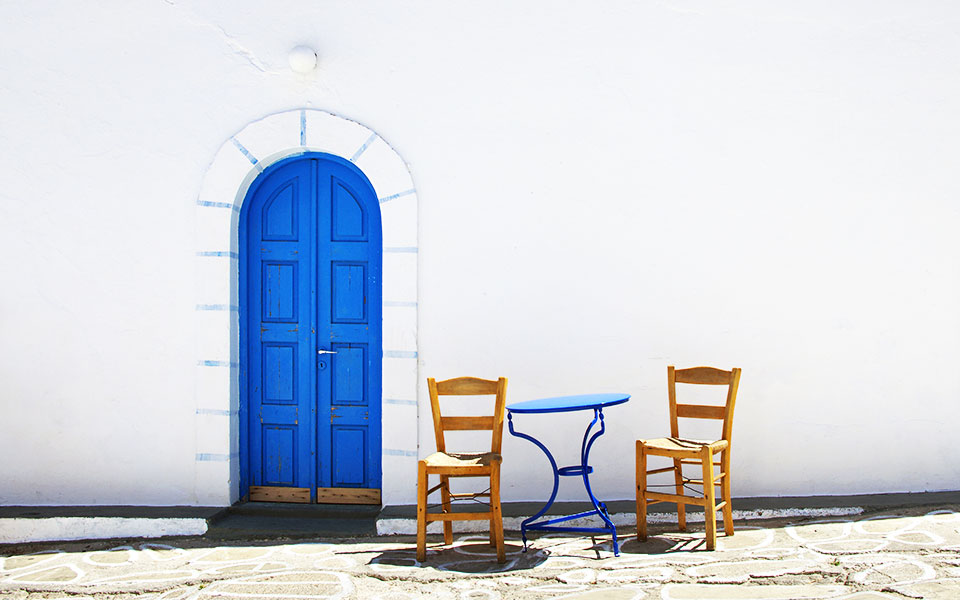
© Shutterstock
Kimolos
Small and friendly, there’s only one town on this island, and this is where you’ll spend most of your time. Here, you’ll explore the alleys, the abandoned castle, the Archaeological Museum, located opposite the Panaghia Odigitria church, and enjoy the blossoming gardens in the yards of the traditional blue-and-white houses. You’ll want to leave town only to discover the many fantastic hidden beaches, for some of which you’ll need to hire a sea taxi. To get to others, put on some comfortable shoes and enjoy a leisurely hike.
Great for: peace and quiet
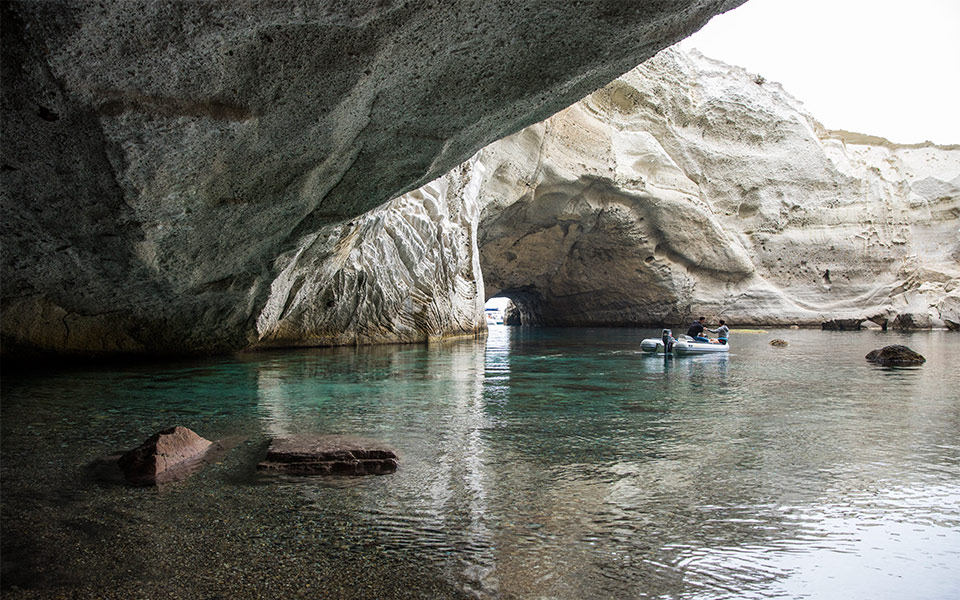
© Nicholas Mastoras
Milos
This island was created over eons by successive underwater volcano eruptions, and its magnificent rock formations will stay etched in your memory as the backdrop of the excursions you make here. People visit for the beaches. Each one more incredible than the last, they are characterized by moon-like landscapes, tall rock pillars that rise from the shallow turquoise water, and coves that were once the lairs of pirates. There are spots where the sea becomes a natural jacuzzi, with warm gases bubbling up from the seabed. Elsewhere, the sand is so hot that it is impossible to walk barefoot. Make sure you visit one of the villages featuring the famous “syrmata” – colorful boathouses dug out of the rock where fishermen traditionally stored their boats in the winter. Many of these have today been converted into unique holiday homes, some of which are available for rent.
Great for: bikini photo shoots
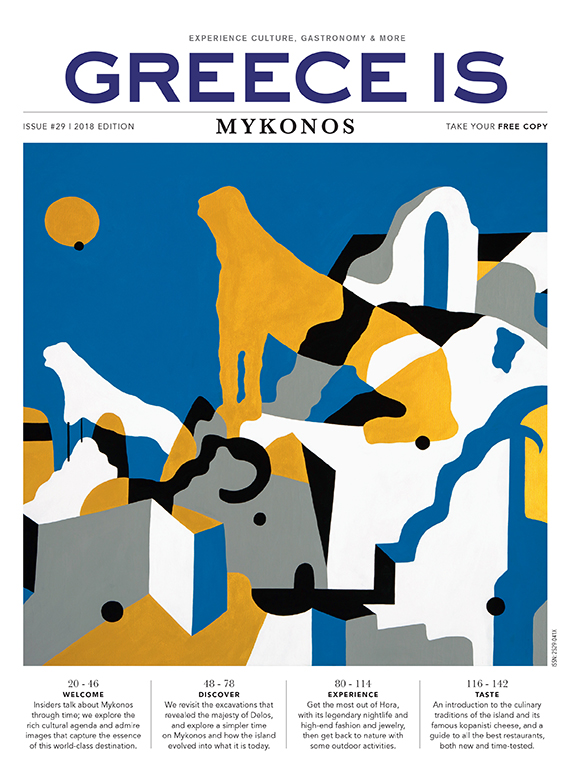

© Johnny Panopoulos
Mykonos
The most famous of all Greek party islands, Mykonos is a legend. Here, you’ll confuse your life for an MTV music video, as drinking and dancing is appropriate everywhere, at all hours of the day. The beach bars are among the best in the world. What you may not know is that Mykonos is also a great place to discover high gastronomy and shop in fantastic stores where Greek and international designer clothes and jewelry take center stage. For those looking for a profound cultural experience, tours by educated guides reveal the life of the island beyond the glitz and glamor, and take you to the unparalleled UNESCO World Heritage Site of the ancient sanctuary on the nearby island of Delos (see below). In our latest issue of Greece Is Mykonos (2018 edition) you’ll find all the tips you need to have the best possible time on the island.
Great for: getting over breakups
You can order our last issue dedicated to Mykonos, Greece Is Mykonos 2018, through our web shop, or read more here.

© Getty Images/Ideal image, Ephorate of Antiquities of Cyclades / Hellenic Republic, Ministry of Culture and Sports / Archaeological Receipts Fund
Delos
If you need a little time away from the buzzing beaches and bars of Mykonos, uninhabited Delos makes for an amazing day trip. Some two to three thousand years ago, life here, on the island that was believed to be the birthplace of the god Apollo, was flourishing. The island was characterized by rituals, festivals, theatrical productions, athletic games and comfortable living in fancy, mosaic-paved houses. Today, the ruin-strewn islet is an extraordinary outdoor museum, and one of Greece’s most important archaeological sites, visited by tourists from all over the world. Entrance to the archaeological site and museum costs 12€. Get here with one of the boats leaving every day from the Old Port on Mykonos.
Great for: history buffs, getting over a hangover
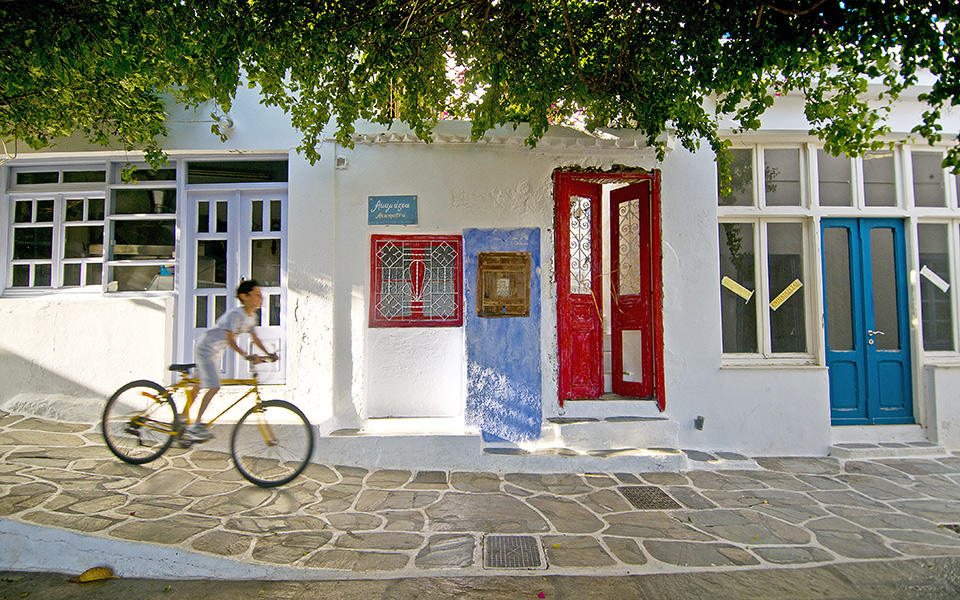
© Clairy Moustafellou
Kythnos
On this Cycladic island, you will never be bored. In fact, you’ll probably find you should have booked a longer stay, as the list of sights is much longer than what might first appear. The ruins of ancient temples and medieval castles, a hydrotherapy facility built in 1840, the iron bridges of the old mines, ravines and chapels are only a few of them. There are two central villages, Hora, aka Messaria, a classic Cycladic village where most hotels are found, and Dryopida, where you’ll discover caves with stalactites and stalagmites, and man-made tunnels. Get to Kythnos by boat from the ports of Piraeus or Lavrio in only a few short hours.
Great for: hikers and adventurous families
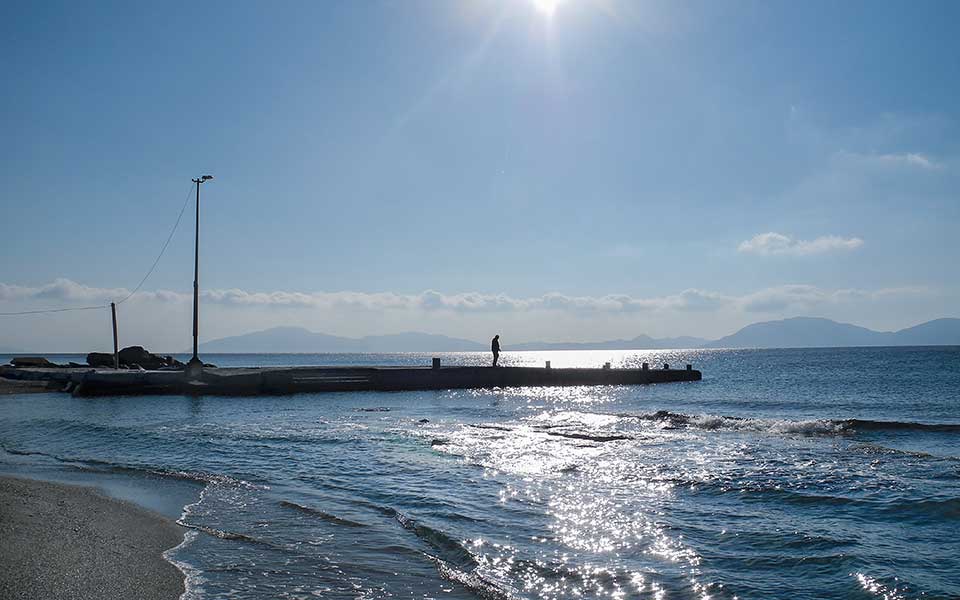
© Christina Karagiannis
Ikaria
While not actually a Cycladic island (it belongs to the islands of the North Aegean) we include it here because if you like the Cyclades, you’ll like Ikaria. During recent years, ever since the publication of Dan Buettner’s article about “blue zones” in National Geographic in 2005, where this island is described as one of the five places in the world where people live longer than normal, Ikaria has been in the public eye. Apparently, thanks to a healthy diet consisting of a little meat and fish, and lots of wild greens and herbal teas (among other things), and the seemingly simple daily routine, close social bonds and slow tempo, locals here enjoy longer lives. Come here to peek into their world, and take lessons home. Their traditional feasts, open to all, are also legendary.
Great for: not dying
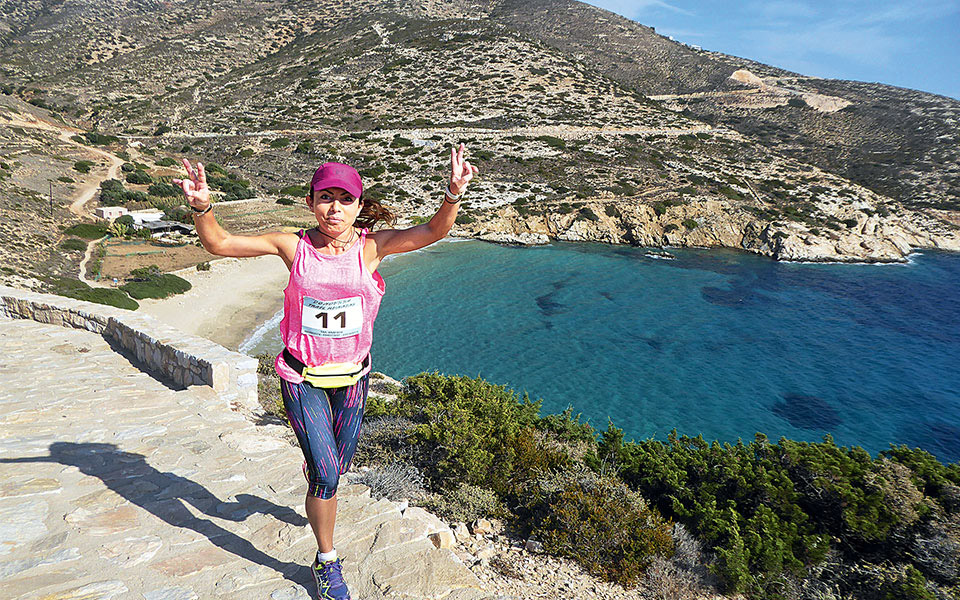
Donoussa
This tiny island, with a population of fewer than 150 residents, only three easily accessible beaches (Stavros, Kedros and Kalotaritissa) and effectively only one developed village (the port of Stavros), has become a popular tourist destination in the last few years. It’s so popular indeed, that the peak of summer is no longer the prime time to visit. For the rest of the year, however, Donoussa is the tiny paradise many travelers are looking for. In October, the popular Donoussa Trail Running event takes place, attracting runners from all over Greece.
Great for: runners
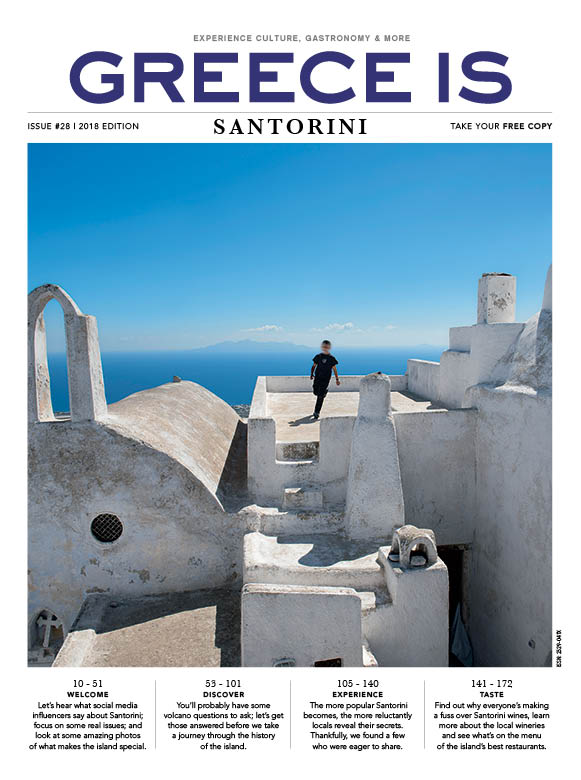

© Giannis Giannelos
Santorini
For many people, whenever Greece is mentioned, an image of Santorini is the first one to come to mind. Considered the ultimate Cycladic island by many, the white and pastel houses and infinity pools of Oia and Thira are a honeymooners’ paradise, a bucket list staple, and a place where A-listers compete with cruise-loads of other tourists for the best spots to watch the sunset over the famed caldera. But there is much more to Santorini. A visit to a vineyard and a tasting of the island’s famous Assyrtiko variety wines is a must, as are excursions to the volcanic sand beaches and to the archaeological site of Akrotiri, “Greece’s Pompeii”. And there is so much more. In our latest issue of Greece Is Santorini (2018 edition) you’ll find all the tips you need to have the best possible time on the island.
Great for: getting engaged
You can order our last issue dedicated to Santorini, Greece Is Santorini 2018, through our web shop, or read more here.
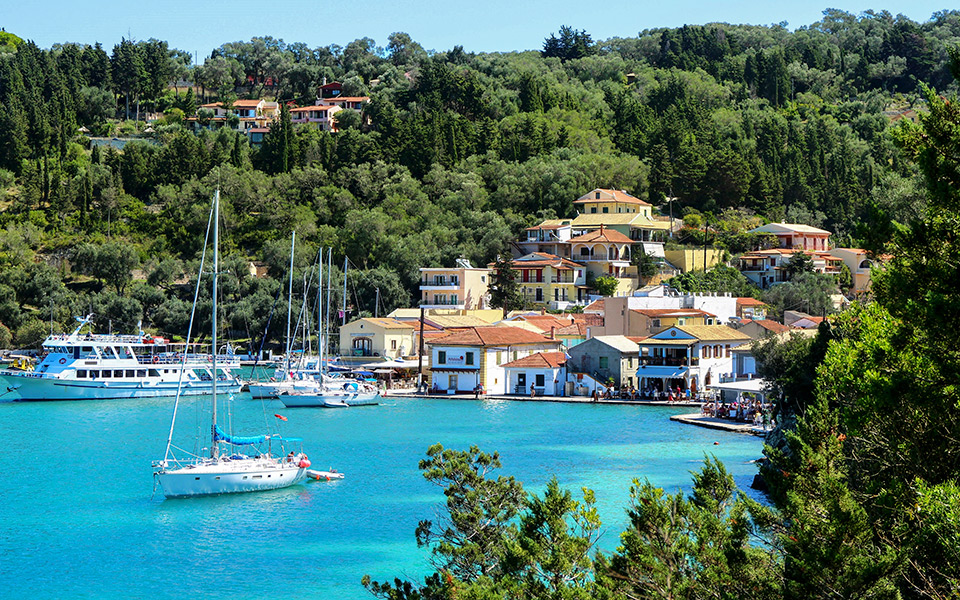
© Shutterstock
Ionian
The Ionian Sea, located south of the Adriatic between Greece and Italy, is dotted with islands some would argue are more beautiful than the Cyclades, as they feature a lot more green. You’ll also find some of the country’s most famous beaches here. Ionian cuisine consists of hearty, Italian-influenced rustic dishes (read more here), that summer vacationers will be inspired to enjoy again in the winter.
Last summer, for the first time, travelers to the Ionian islands were able to easily hop between the islands, thanks to the operation of a new ferry line which linked all of the islands in the group for the first time.
Besides these destinations below, you can find articles about other Ionian islands through the “Destinations” tab on our homepage.
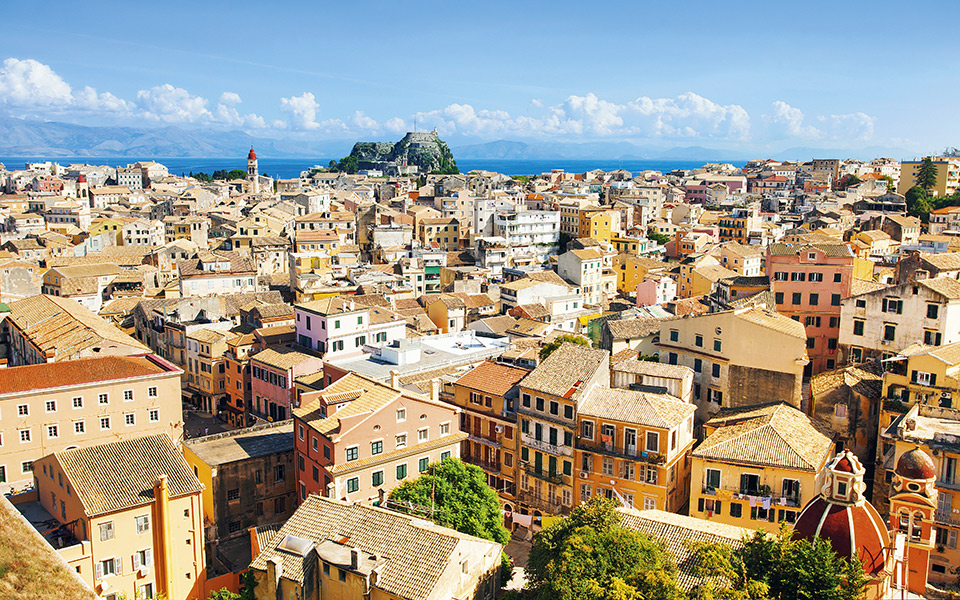
© Shutterstock
Corfu
Popular as ever (actually seeing a 10% increase in the number of arrivals in 2018), Corfu gets seriously packed with people in the summer. Visiting in spring or early fall, the island is even more enjoyable. During these months, when the weather is not too hot, you can really enjoy the sights around the island. Take a stroll through the gardens of the Mon Repos estate, with its 2,000 species of plants, flowers and age-old trees, surrounding a British palace from 1831. In Corfu Town at night, when the stores have closed and most people are either sleeping or enjoying a drink at a bar, take a walk through the Old Town. Seeing it without the crowds can make you fall in love with Corfu all over again.
Great for: meeting (lots of) people
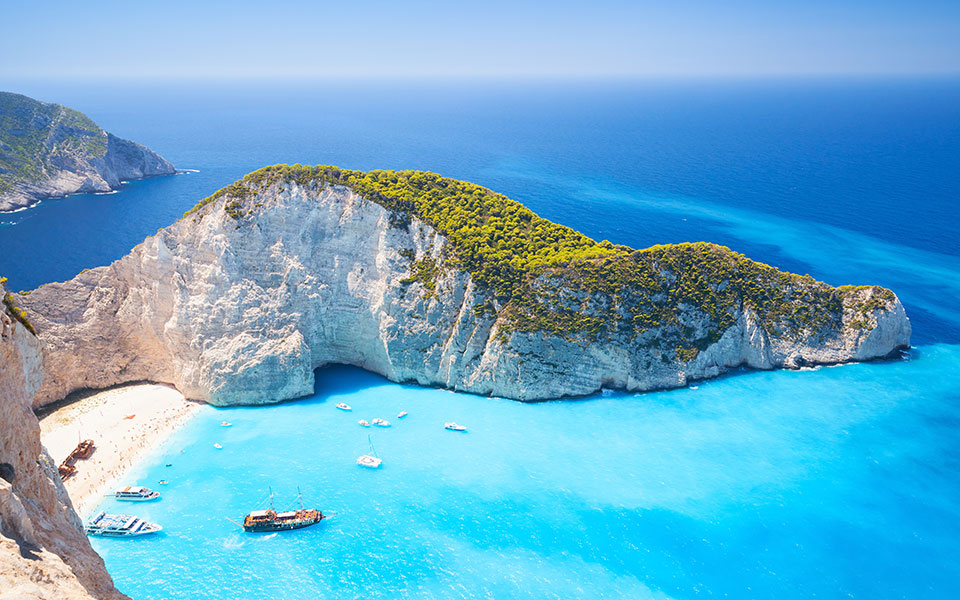
© Shutterstock
Zakynthos
If you think you don’t know Zakynthos (aka Zante), you’re wrong. You’ve seen photos of it a million times, because the island is home to the most famous beach in Greece, and photos of it are used by travel agencies the world over. You know the beach; it’s the one in the cove with the shipwreck in the center, popular with families and base jumpers alike. Navagio (Shipwreck) Beach is worth putting on your bucket list, and you should go fast because, following a small landslide here last summer, no one knows if it will stay open to the same number of visitors in the future. But Navagio isn’t the only popular beach on Zakynthos, and watersport lovers are particularly at home here. One water sport, subwing, was even invented on the island.
Great for: adrenaline junkies
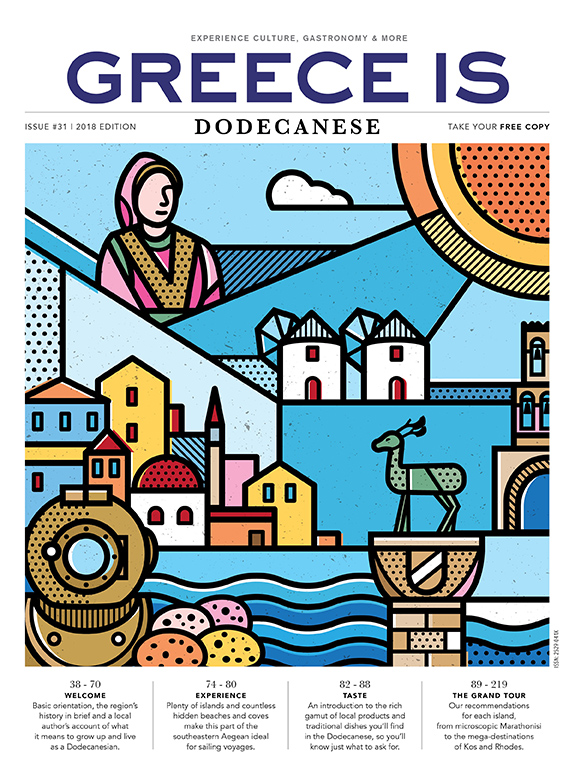
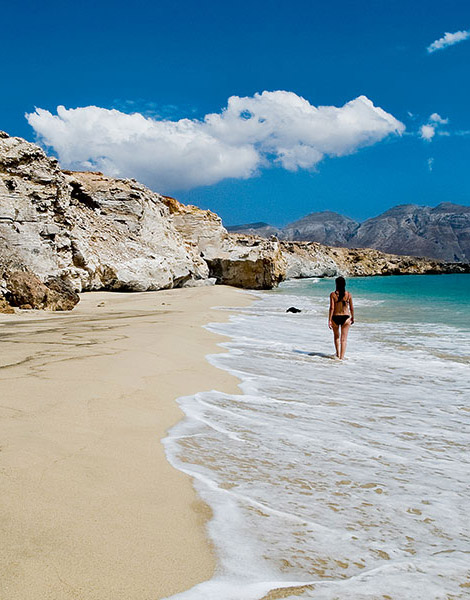
© Clairy Moustafellou
Dodecanese
History and its remains set the main islands of the Dodecanese, in the southeastern Aegean Sea, apart from others. They were under the rule of the Knights of St John for roughly two centuries (ca. 1306-1522), and under Italian occupation for several decades (1912-1943), and all periods have left traces in everything from architecture to the local gastronomy (read more here).
The name of this island group suggests the islands are fewer than they really are (“dodeka” = twelve). There are actually many more – fifteen main islands and 93 smaller islands to be exact, and we love too many of them to list them all here.
Besides these destinations below, you can find more articles about the Dodecanese islands through the “Destinations” tab on our homepage. You can also order our first magazine dedicated to the island group, Greece Is Dodecanese 2018, through our web shop, or read it here.
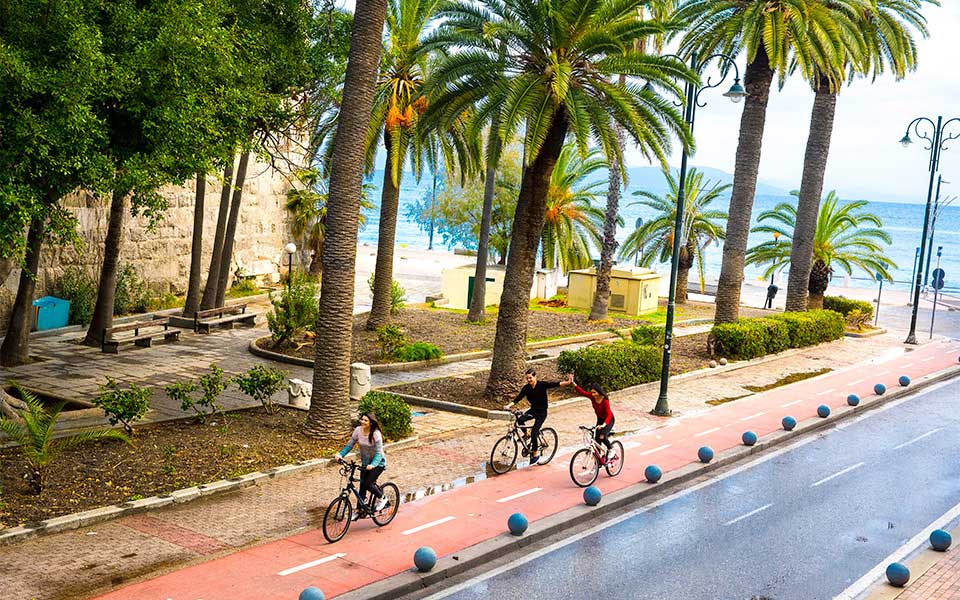
© Dionysis Kouris
Kos
Biking is the best way to get around on this island, with a bicycle path that runs all the way from Faros Beach in the east to Psalidi Beach in the west. In Kos Town, the path links two archaeological parks, making it easy to spend a day exploring the past. Everywhere you go on the island, in fact, history is on display. At Aghios Stefanos, you can have a swim right beside two Early Christian churches from the 5th-6th century. You’ll also find Byzantine churches on the island, as well as fortresses, Roman-era houses, and the Ascleipon – a Koan sanctuary dedicated to the divine healer Asclepius and his daughter Hygeia (Health, Hygiene), where Hippocrates, the father of modern medicine, once trained to became a physician.
Great for: history buffs

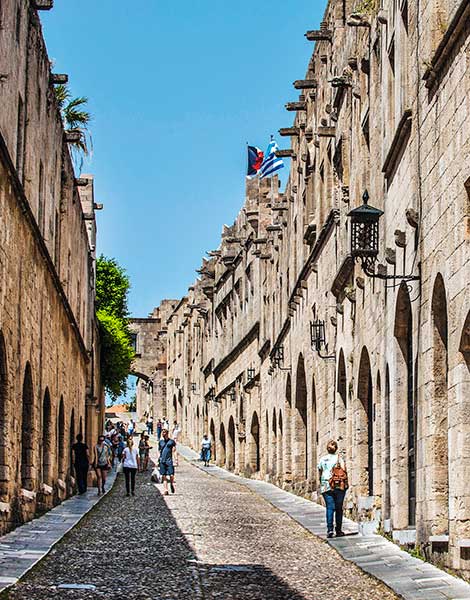
© Clairy Moustafellou
Rhodes
The largest island of the Dodecanese deserves more than one visit. On your first, unless you’re staying for an extended period of time, you’ll have to choose between the sights. In the Old Town alone, the impressive buildings built by the Knights of Saint John in the 12th century, all deserve to be discovered. Restored by the Italians in the early 20th century, this part of town is still home to some 2,000 residents (who just happen to be living in a UNESCO World Heritage Site). A visit to the city of Lindos is also a must. Then there’s the Valley of the Butterflies, the Seven Springs, the castles and the little villages, the gorgeous Anthony Quinn beach, and much, much more. The only question is, where will you start?
Great for: the easily bored
You can order our print issue dedicated to Rhodes, Greece Is Rhodes 2018, through our web shop, or read it here.
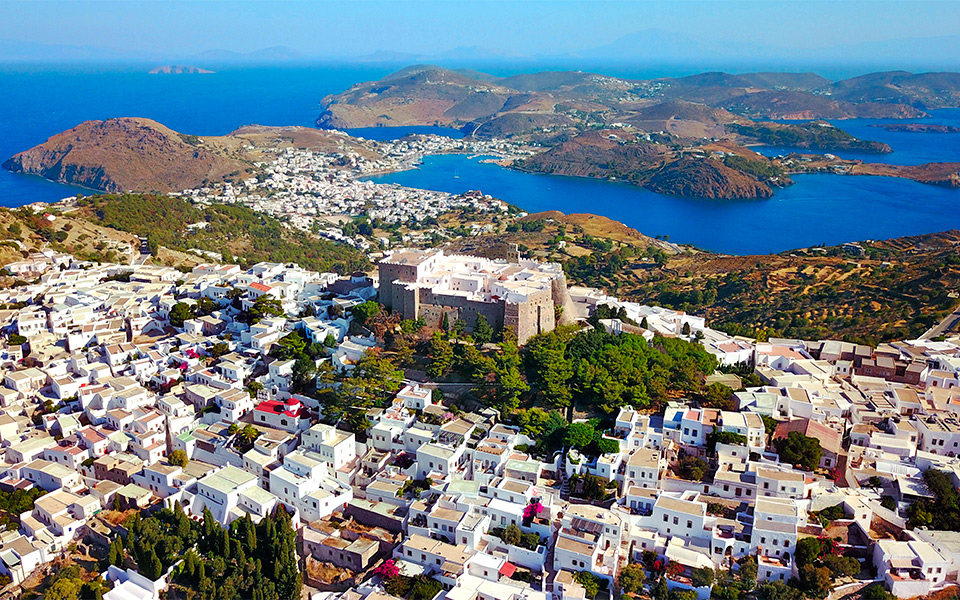
© Shutterstock
Patmos
The overall atmosphere on Patmos is at once cosmopolitan and discreet – a unique combination. The monastery that crowns the main village is a UNESCO World Heritage Site, built near a cave where Saint John the Theologian is said to have penned the Book of Revelation. In addition, the main town, Chora, is special as it was built to resist attacks from pirates. Built just below and around the fortified monastery, the 16th century homes all stand close together, and feature flat rooftops. They were built this way so as to create an “overhead” transport and communication network, so that vulnerable parts of town could be quickly reinforced. The island also features some fantastic beaches, and an overall low-key vibe.
Great for: movie buffs (the International Aegean Film Festival is held here in July)
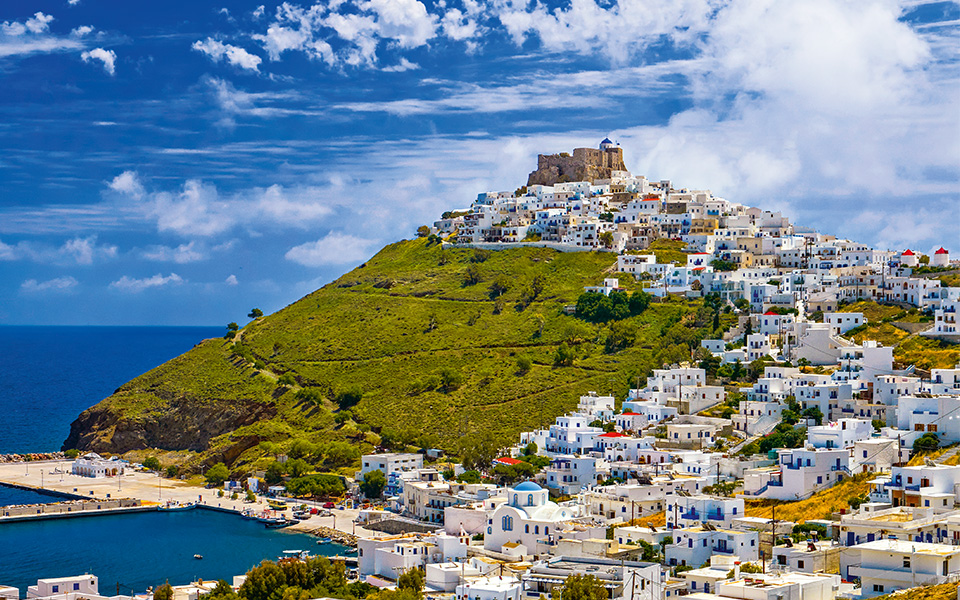
© Perikles Merakos
Astypalea
Many consider the main town of this butterfly-shaped island, also known as Astropalea by its roughly 1,200 permanent residents, to be the prettiest in the Aegean. Belonging to the Dodecanese but located near the Cycladic islands, the architecture reflects a beautiful blend of the two island groups; Dodecanesian features such as pastel hues, large windows and a tendency for ornamentation are mixed with Cycladic elements such as rectangular lines, the use of white and smaller structural openings. Watching the moon rise above the castle is a must here.
Great for: family vacations

© Nicolas Smalios
Kalymnos
In the past, the people of Kalymnos were known as experts when it came to exploring the depths of the sea, as it was defined by one of the most dangerous professions in the world: sponge diving. Today, many visitors to the island will instead explore its peaks, as it’s been discovered as a great rock-climbing destination. With more than 3,800 routes and dozens of schools, the peaks are crawling with climbers in the summer and autumn. Of course, diving is still possible as well. Home to the first-ever state-owned school for professional divers, the island is exempt from the diving restrictions that exist nearly everywhere else in Greece and is ideal for underwater explorations. You can learn more about the history of sponge diving in Kalymnos at the small Naval Museum and at the Traditional Kalymnian House.
Great for: climbers and divers
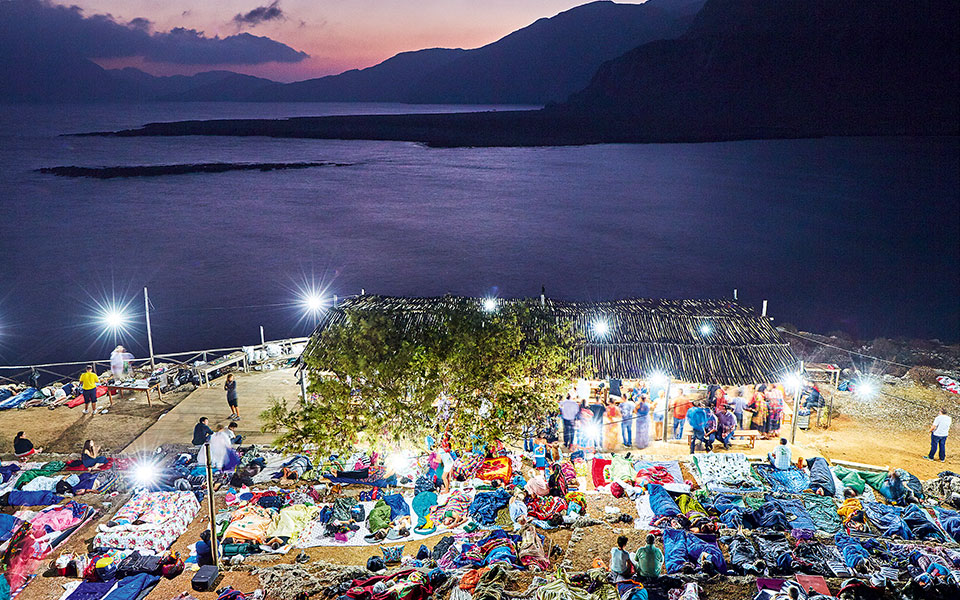
© George Tsafos
Karpathos
On Karpathos, you’ll want to go beyond the main harbor, as the natural attractions, museums and sights are spread across the island. The village of Olympos is like a small time capsule. Due to its remote mountain location, this village remained a closed society for centuries, with electricity and road access available only since the late ‘70s, and while tourists have found their way here today, it still feels like a living folk museum. Sporty and outdoorsy types will love Karpathos for its rugged landscape (great for hiking and rock-climbing) and beaches (with good windsurfing opportunities and interesting places to dive and snorkle).
Great for: visiting at the end of August, for the unique panigyri (traditional feast) hosted by the people of Olympos at the remote cave church of Aghios Ioannis.
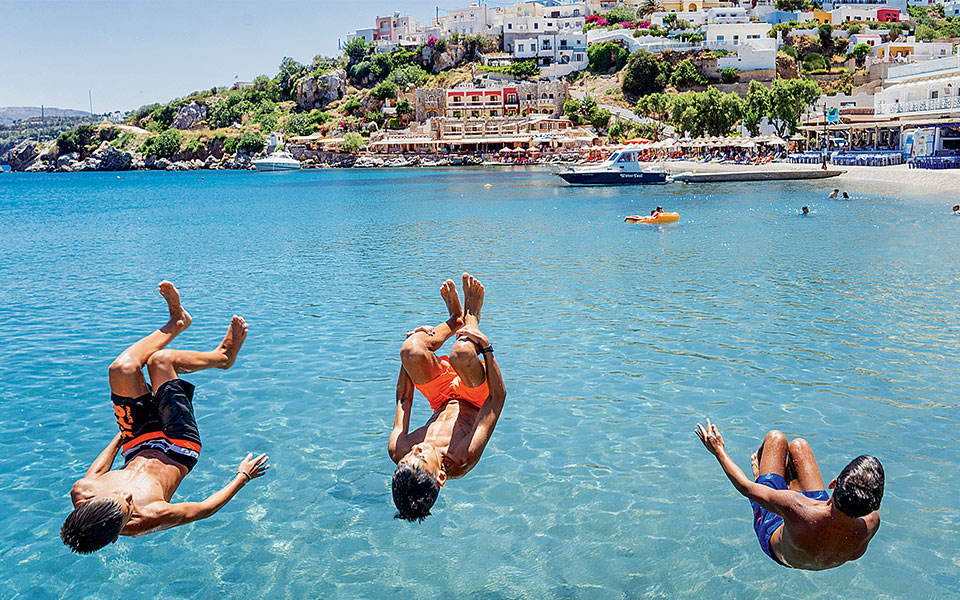
© Perikles Merakos
Leros
The main town on Leros, Lakki, was built from scratch by Italian dictator Benito Mussolini in the 1920s, in order to establish a base for the Italian Navy. Featuring a mix of Modernist, Bauhaus, Renaissance, Venetian and Islamic elements, with large light-colored surfaces, horizontal openings and Cubist whimsy, it’s considered to be the only true rationalist town outside of Italy, and has been dubbed “the weirdest town in Greece.” War history buffs should check out the preserved coastal batteries and the Tunnel War Museum. Offshore, numerous barges, landing craft, airplanes and anti-submarine nets remain visible on the seabed all around the island.
Great for: architecture aficionados and shipwreck divers
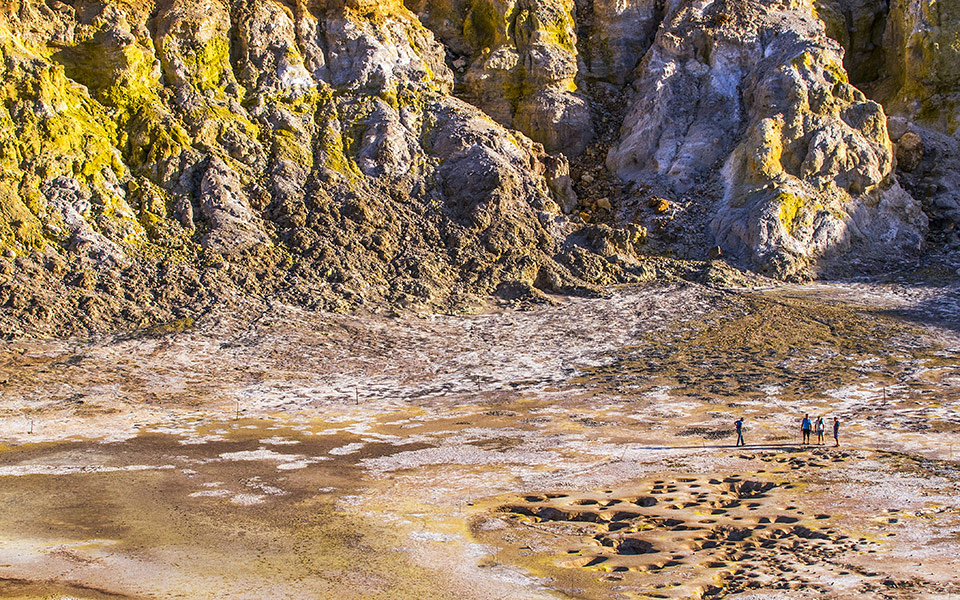
© Clairy Moustafellou
Nisyros
On this volcanic island, you can take a walk around one of the most accessible hydrothermal craters in the world, with a diameter ranging from 260m to 330m and a depth of 27m, with an otherworldly surface of hydrogen sulfide-puffing holes (fumaroles). The Volcanological Museum, the only one of its kind in Greece, located at a prime spot on top of the caldera and offering panoramic views of the Stefanos crater, features a collection of 250 volcanic rocks and is a great source of information about volcanoes. Swimming here is also an experience, whether at Hohlaki Beach, with its big blue-black volcanic pebbles, or in the natural hot baths, located approximately 1.5km from the main town of Mandraki.
Great for: mineral lovers
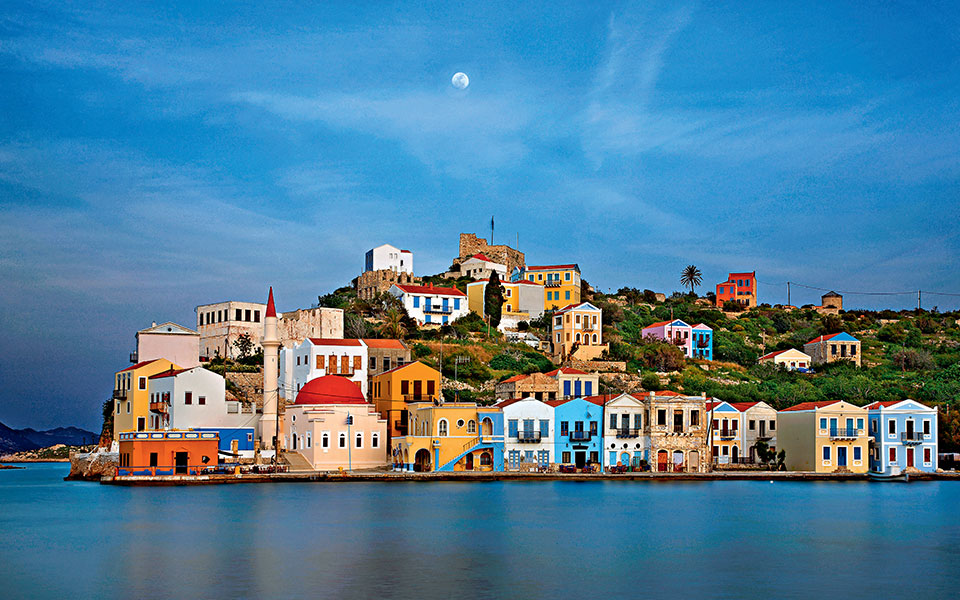
© Shutterstock
Kastelorizo
Reaching Kastelorizo, the first thing you see is enough to make you fall in love. The small, car-free main town looks like a painting, with its colorful houses and its harbor full of caiques. Only about 500 people live on this Instagrammable island, but that doesn’t make it boring; there are plenty of things to see and do. You’ll find the Aghios Nikolaos Castle, built by the Knights of the Order of Saint John in the 14th century, a 4th c. Lycian Tomb and two museums mere walking distance from the port. Perhaps the most memorable experience however – aside from hanging out in the beautiful port – is a visit to the famous Blue Cave, accessible by boat. The opening in the rock is so small that the boatman will ask you to lie flat to enter. Swimming in the cave, in the stunning reflected light, is a unique experience.
Great for: instagrammers
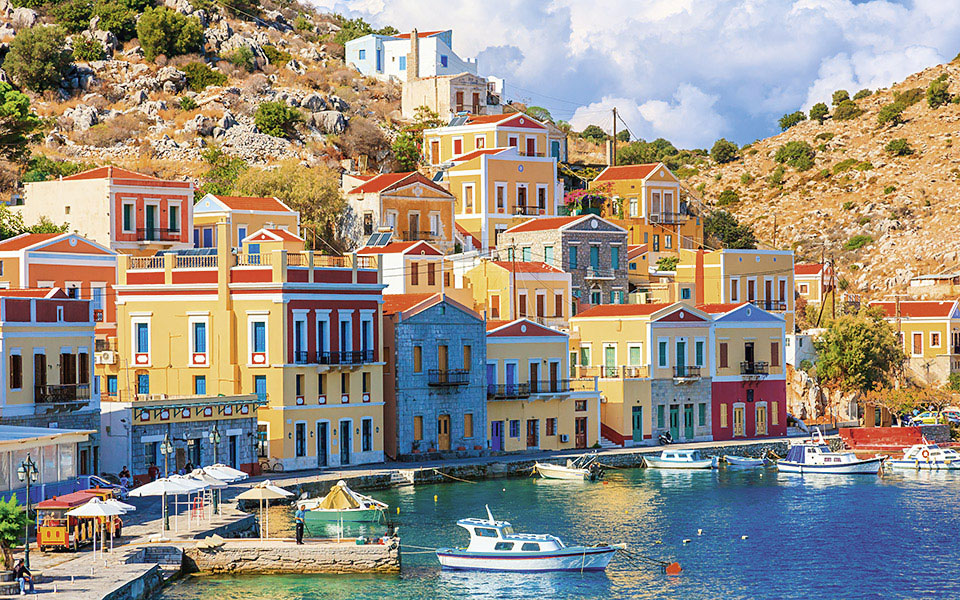
© Shutterstock
The Tiny Islands of the Dodecanese
There are many more wonderful destinations in the Dodecanese that we love – too many to include here, but some other tiny islands worth visiting are: Telendos, where you can explore a sunken city with just a mask and snorkel, Arki, boasting the famous Tiganakia beach, Kasos, with its exceptional local cuisine, Symi, home of the important Monastery of Panormitis, Tilos, where the very last wild elephants in Europe lived, Marathi, Lipsi, Agathonisi and Pserimos where all the clothes you need is a swim suit, and Halki, the smallest of them all, where time literally stands still (or at least the clock in the church tower does to spare the residents the noisy tolling of the bell).

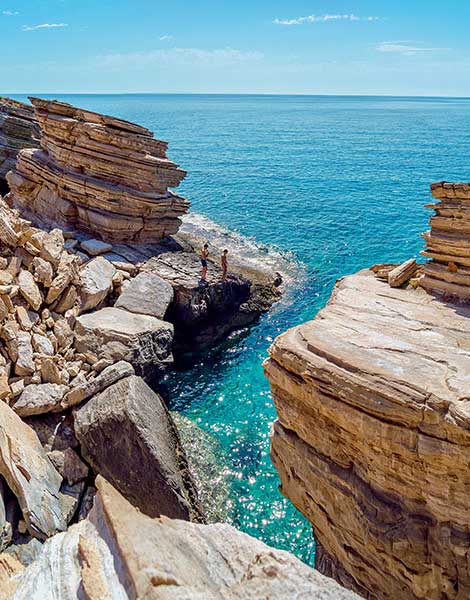
© Shutterstock
Crete
Greece’s largest island, situated in the southern Aegean Sea, is known for its varied and rugged terrain. Walking it from end to end (on the E4 European long-distance path) takes about a month, and every destination on the island offers its own specific charm. The largest cities, Heraklion, Rethymno and Hania (east to west, respectively), are situated on the island’s northern coast, but excursions to the villages in the mountains and on the southern side will provide memories to last a lifetime – not least thanks to the food. Many medical studies have found the Cretan diet to be of significant benefit to human health (read more here).
Besides these destinations below, you can find articles about Crete through the “Destinations” tab on our homepage. You can also order our first magazine dedicated to the island, Greece Is Crete 2018, through our web shop or read it here.
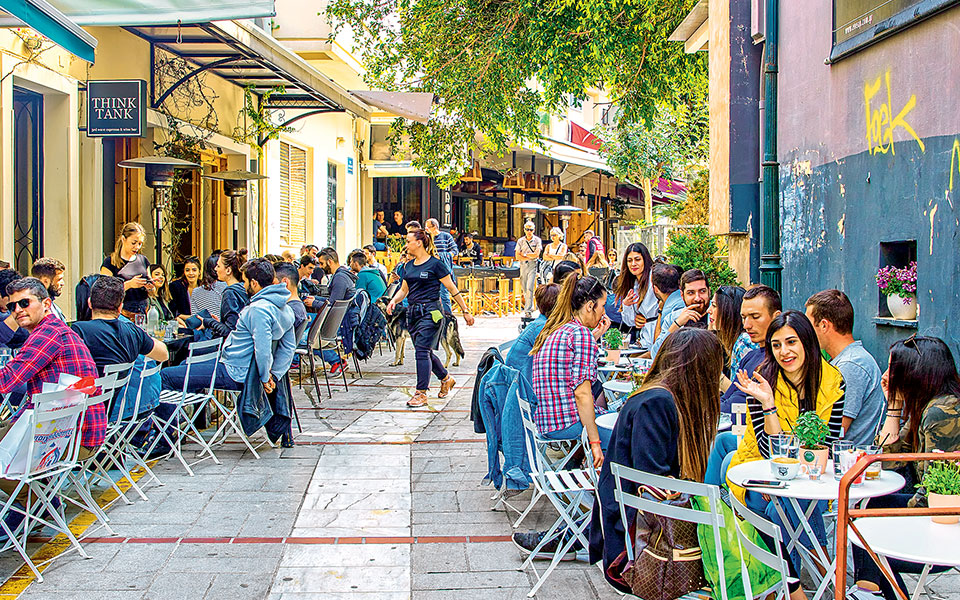
© Getty Images/Ideal Image
Heraklion
The city whose harbor once served as a port for Knossos, the Bronze Age capital of the Minoan civilization, is today’s capital and university town of Crete. While it’s certainly not the most beautiful city on the island (the towns below are hard to beat), it is vibrant and happening. Come here to enjoy the local nightlife, including some obligatory raki and meze at the kafeneia (traditional cafés), and to visit one of the most famous archeological sites in all of Greece – the Palace of Knossos. Lately, many efforts have been made to improve the city, making it more pleasant for locals and attracting more visitors as well. And it has paid off. In fact, Heraklion is one of Europe’s fastest growing tourism destinations today.
Great for: hanging out with 20-somethings
Read more about the city here, and about the surrounding region here.
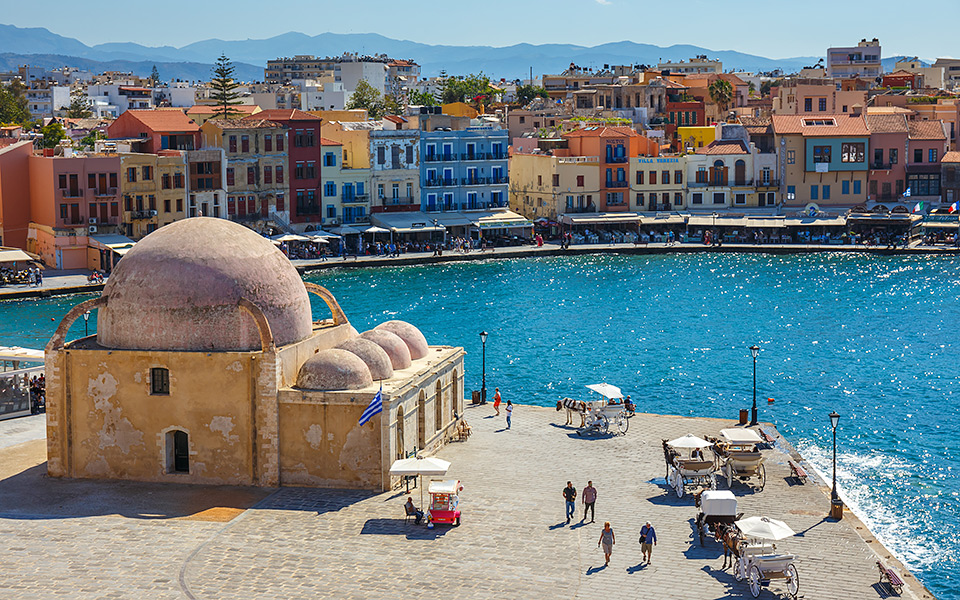
Hania
Known as the “Venice of the East”, Hania’s Old Town is considered one of the best-preserved in Greece. Neolithic people, Minoans, Mycenaeans, Dorians, Romans, Andalusian Arabs, Byzantines, Venetians, Genoese, Egyptians and Ottomans all left their unique mark for all modern-day visitors to see. The Venetian harbor is almost distractingly charming, but you shouldn’t miss the rest the town has to offer. A popular August destination among young Greeks, the nightlife here is excellent, and the beach parties are some of the best in the country – as are the beaches in the region in general, with Elafonisi, with its pink sand, being the most famous. In the nearby Akrotiri area, one can trace the evolution of religious customs across the centuries, visiting the many monasteries and chapels.
Great for: history buffs, party people
Read more about the city here, and about the surrounding region here.
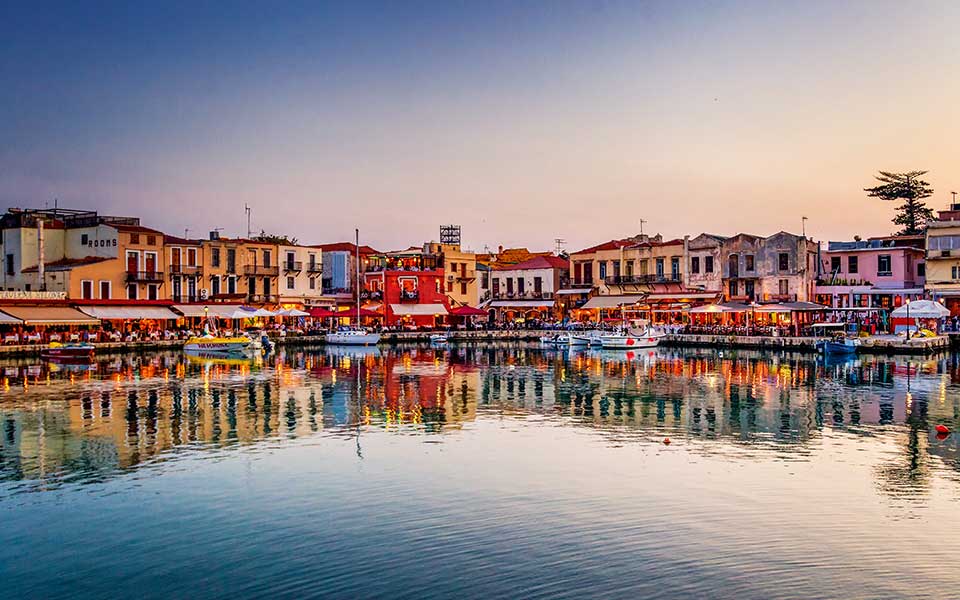
© Pericles Merakos
Rethymno
Built on a cape, Rethymno boasts a wonderful old harbor, full of color, lined with Venetian and Ottoman buildings that have been reflected in its calm waters for centuries. Another historic town, the Venetians turned Rethymno into one of the most important cities on the island and created its strong association with the Renaissance, which is celebrated during the Renaissance Festival every summer. It’s worth paying visits to the Fortezza, the Venetian citadel, built between 1573 and 1580. Within the Old Town, look for the 16th-century Venetian Loggia, a splendid Palladian-style architectural masterpiece, the Rimondi Fountain (1626), which once supplied Rethymno with cool water from Mt Vrysinas, and the Neratze Mosque, with its three domes and 27m-tall minaret. The southern coast of the region also boasts some of the islands most impressive beaches.
Great for: explorers and history buffs
Read more about the city of Rethymno here, and about the surrounding region here.
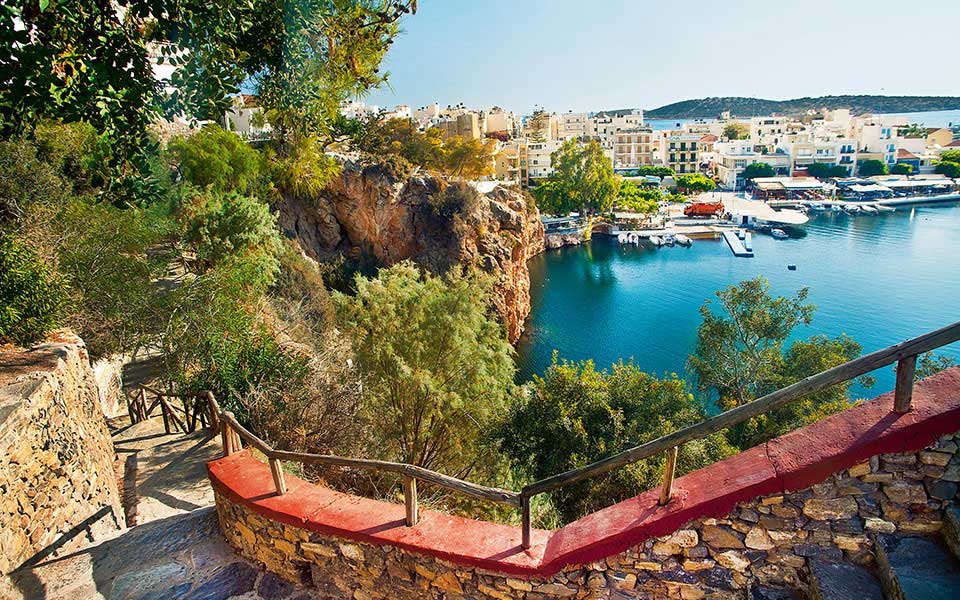
© Nikos Kokkas
Lasithi
The Lasithi region, featuring the little town of Aghios Nikolaos, is full of surprises. Many visitors base themselves at the award-winning resorts in Elounda, featuring some of the best spas in the world. Here, you’re only a short drive and a boat ride away from the island of Spinalonga, a popular archaeological site with pending UNESCO World Heritage status (you might remember it from Victoria Hislop’s “The Island”). In Aghios Nikolaos, built on the site of the ancient city of Kamara, overlooking Mirabello Bay, you should visit Voulismeni Lake, which is connected to the sea by a narrow channel. A wonderful natural attraction, it’s also a place where you can feel the pulse of the town – full of life in summer, and the venue for an international cliff-diving competition.
Great for: family vacations
Read more about the region of Lasithi here, and the town of Aghios Nikolaos here.
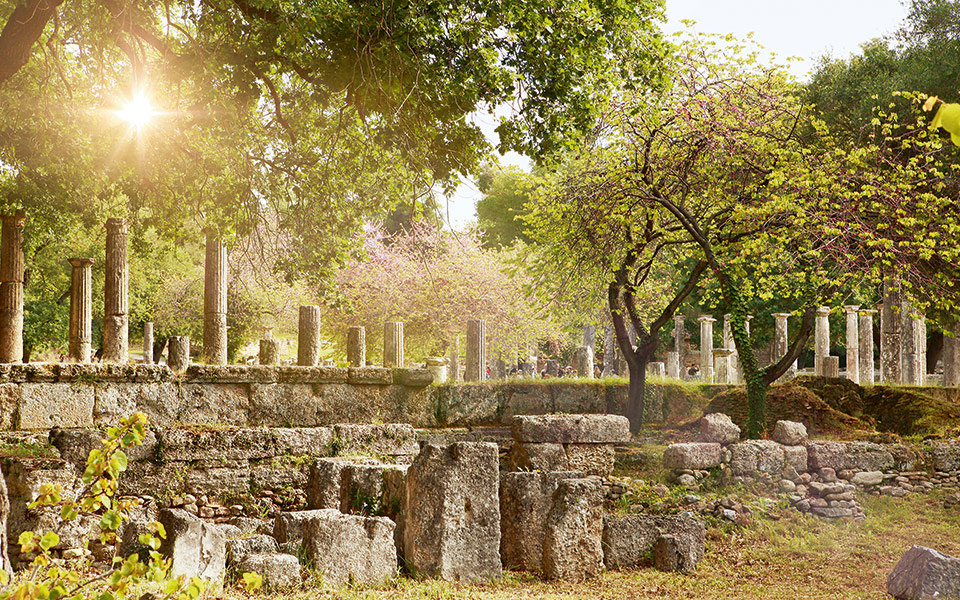
© Mythical Peloponnese
Peloponnese
This peninsula south of the Greek mainland covers over 21,500 sq. km, and comprises a source of incredible natural wealth. With a 1,200-kilometer coastline, it’s as well-suited for summer vacations as the islands, yet the mountains, with their forests, lakes, rivers and waterfalls and even a ski resort also provide picturesque escapes for those who dislike the heat, as well as for relaxing winter getaways. And that’s not to mention incredible cultural sites like Ancient Mycenae, Ancient Olympia, Ancient Messene, Mistras, Nafplio, Monemvasia and more. In short, the Peloponnese has all the natural and cultural capital needed for all kinds of tourism. The local cuisine is dependent on nature, earthy and simple, utilizing the best seasonal produce.
Besides the destinations below, you can find more articles about the Peloponnese through the “Destinations” tab on our homepage, or order an issue of Greece Is Peloponnese (2015-2016) through our web shop.
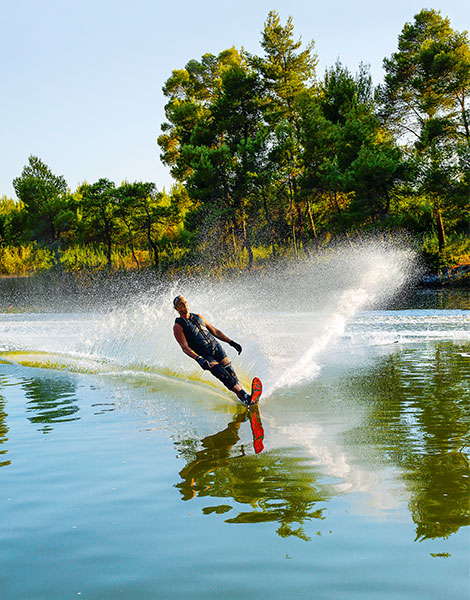
© Nikos Kokkas
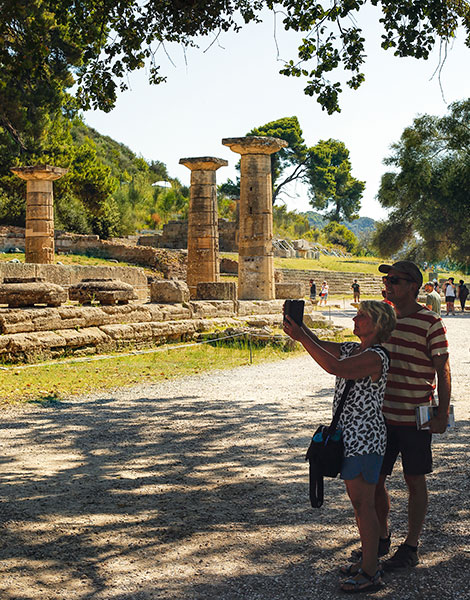
© Nikos Kokkas
Ilia
In the Ilia region, many cruise ships dock at the little port of Katakolo, a small village that resembles those on the Ionian islands. The main reason to come here is Ancient Olympia – the birthplace of the Olympics and one of Greece’s most revered ancient sites – which is busy from early in the morning. Here you’ll learn all about the early Olympic games, and pose for some fun photos at the starting line of the Stadium. It is worth it to pair a walk around the site with a visit to the Archaeological Museum and the Museum of the History of the Ancient Olympic Games, which are home to many interesting displays. South of Katakolo is the renowned Kaiafas Lake, where many come for waterskiing and healthy dips in the water of a local thermal spring.
Great for: educational family vacations

© Hayley Prokos
Kalamata
More than olives (though the olives are pretty damn good), the south Peloponnesian city of Kalamata features everything you want from a city destination: sights, a historic district, and plenty of dining and entertainment options. Combining all of these elements, in summer, you can often catch a play in the old fortress above the agora, or a performance at the renowned International Dance Festival. All of this, plus it has plenty of options for swimming and exploring. Of course, your visit won’t be complete without a trip to an olive mill. Take a walking tour of the fields, learn the process of producing olive oil and participate in a tasting.
Great for: foodies, city breakers who have already seen Athens & Thessaloniki
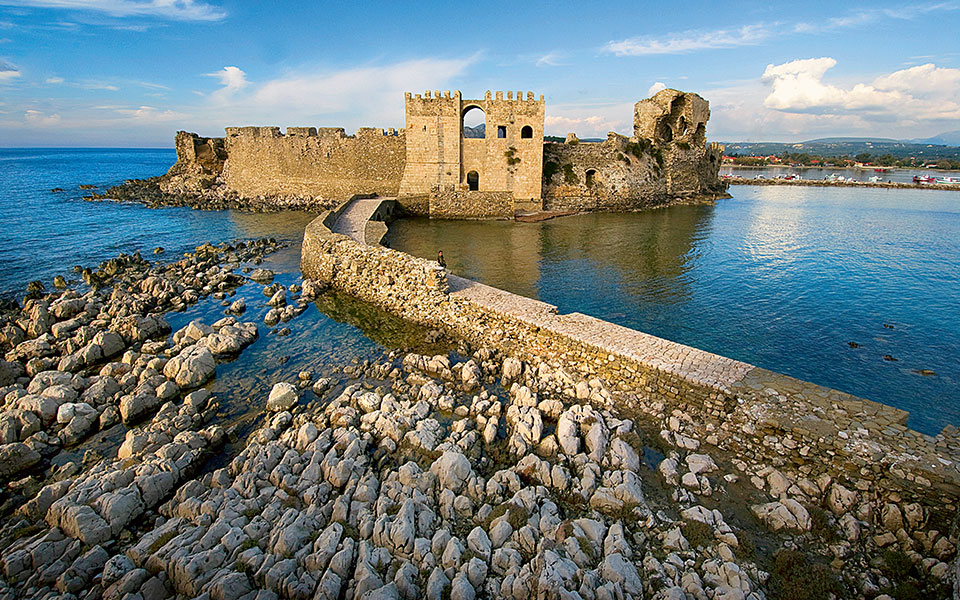
© Clairy Moustafellou
Methoni & Koroni
These two small castle towns, only a half-hour drive apart, on the southwestern side of the Peloponnese, are a great 2-for-1. With similar histories (their castles flourished during the Venetian occupation, between 1207-1500), they are equally charming, featuring traditional settlements, rose bushes and catacombs – all set against the infinite blue of the sea. As tourist destinations, they complement each other, especially for guests who come for the watersports; Koroni can be great for classic surfing, and Methoni draws kite surfers. Note that Zagka Beach, located beneath the castle of Koroni, and a portion of Memi Beach are favored nesting sites for the sea turtle Caretta caretta (about 45 nests are observed every year).
Great for: GOT fans and reenactors looking for inspiration, surfers, lovebirds
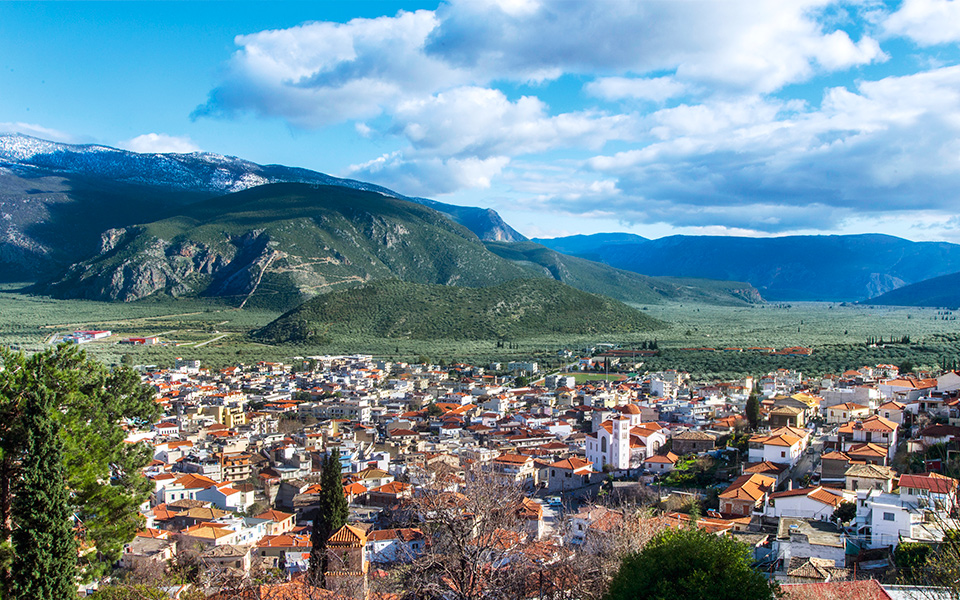
© Clairy Moustafellou
Mainland
Greece’s mainland is as diverse as the country is as a whole. Considering the giant beach-side family resorts, the rural mountain settlements, the tiny fishing villages, and the vibrant cities, it’s impossible to define the mainland as a whole. This year alone, we fell in love with several small towns and villages, rekindled our love affair with major cities, and discovered natural landscapes and wildlife few would imagine to find in Greece.
Besides the destinations below, you can find articles about the Greek mainland through the “Destinations” tab on our homepage.


Athens
According to a recent survey, archaeological attractions are no longer the sole reason that many tourists come to Athens; they’re also attracted by the city’s modern cultural life, its residents’ attitude, and its entertainment and leisure scene. In our latest print issue of Greece Is Athens (Winter 2018-2019 edition), we dive into the creative side of the city; the exciting art scene, the rise of shared work spaces, the quirky boutique hotels, and much more. Of course, the ancient sites are always a reason to come to Athens – even if you’ve seen them before. The Acropolis Museum (ranked sixth in the world by TripAdvisor), for example, will be granting public access to a whole new subterranean level in 2019.
Great for: city breaks
Soon, you’ll be able to order our last issue dedicated to Athens, Greece Is Athens Winter 2018-2019, through our web shop (for now, you can order the summer issue).

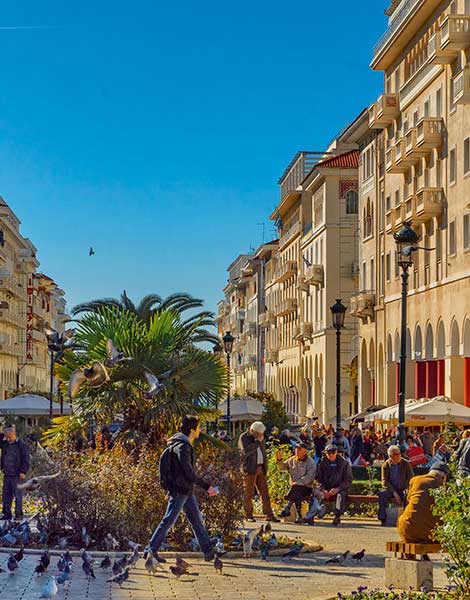
© Pericles Merakos
Thessaloniki
If you have yet to visit Greece’s second largest city – yes, you have missed out, but the good news is that this destination just keeps getting better and better, inspiring a huge surge in popularity (for the period January-September 2018, overnight lodgings reached 2.59 million). Research says that the main reason people visit is the city’s distinct personality. In other words, you don’t come here for one sight or experience, but for the whole package; the city has become attractive for its highly sophisticated gastronomy, its modern cafés and bars, its intimate and contemporary museums, the numerous Byzantine, Ottoman and Jewish monuments that are scattered throughout, the aura of nostalgia of the Ano Poli (Old City), and the youthful vibes in the fast-evolving Ano Ladadika district.
Great for: film buffs (the city’s main film festival is hosted annually in November)
You can order our last issue dedicated to Thessaloniki, Greece Is Thessaloniki 2018-2019, through our web shop, or read it here.
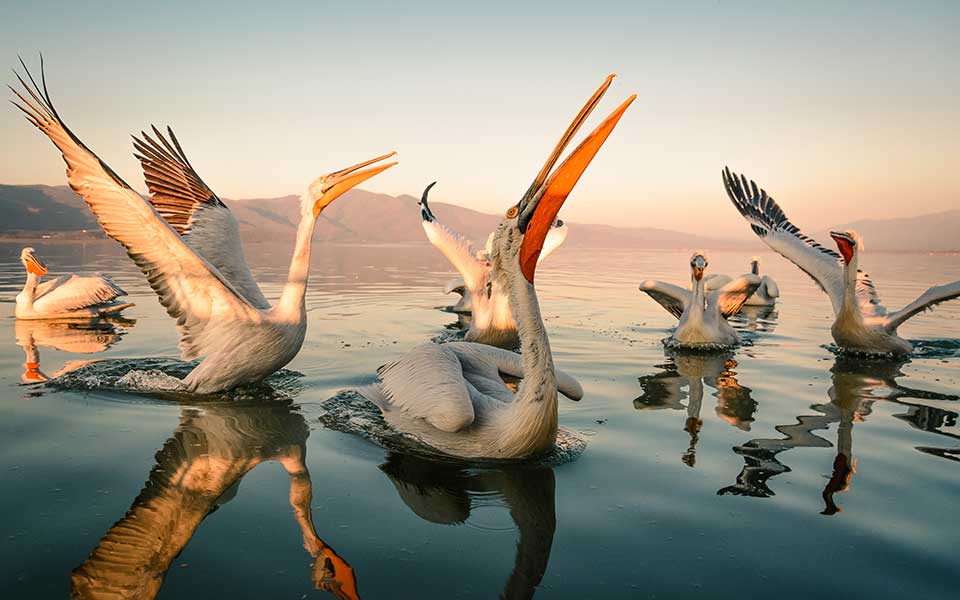
© Shutterstock
Lake Kerkini
Kerkini – one of Europe’s most important wetlands and part of the Natura 2000 network of protected sites, and an artificially created freshwater lake here attract over 320 species of birds every year, including flocks of pink flamingoes, white-fronted geese, and pelicans. Here, no expertise is needed to birdwatch, and it’s an amazing experience. However, there is more to do as well. Among other things, you can relax in the Byzantine bathhouse, go on a 4×4 safari or a two-day horse-riding excursion, or visit the WWII Fort Roupel, near the Greek-Bulgarian border (here, soldiers and officers will give you a tour of part of the fort, a WWII memorial, and the military museum that houses weapons, medals, uniforms and photographs).
Great for: birdwatching
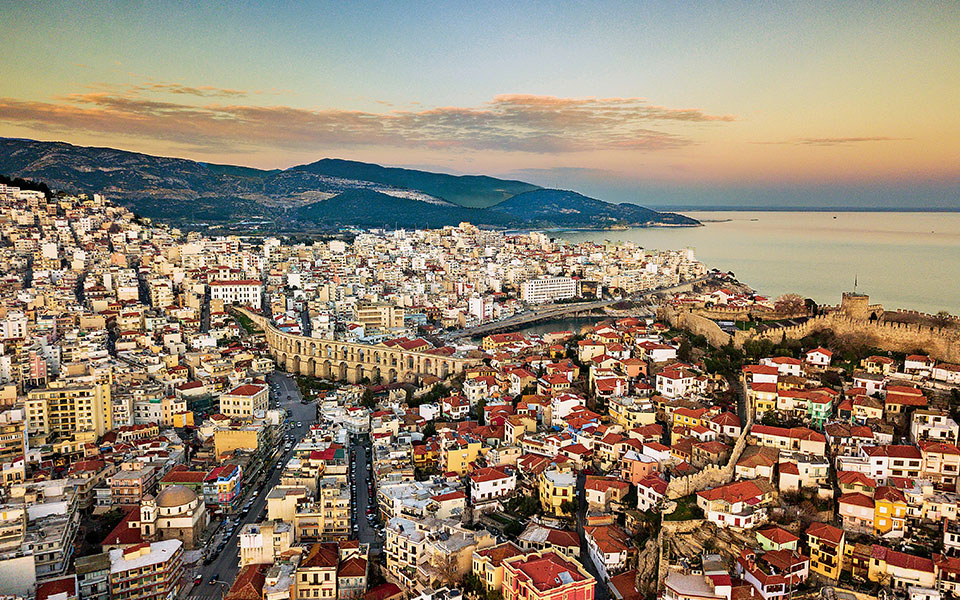
© Nikolas Mastoras
Kavala
For those visiting Thessaloniki, Kavala, less than an hour’s drive away (5.5-6 hours from Athens), makes an excellent day excursion. Amphitheatrically built overlooking the sea, the coastal city is divided into the New Town, and the Old Town. In the Old Town, elements harking back to a number of eras and architectural styles coexist throughout the narrow lanes, under the city’s castle. Plenty of Ottoman buildings here are worth a visit (most famous is the Imaret, which now houses a hotel). Also worth visiting are the Archaeological Site and Museum of Philippi, the Sacred Baptistry of St Lydia, and the House of Mohammed Ali.
Great for: day trips from Thessaloniki
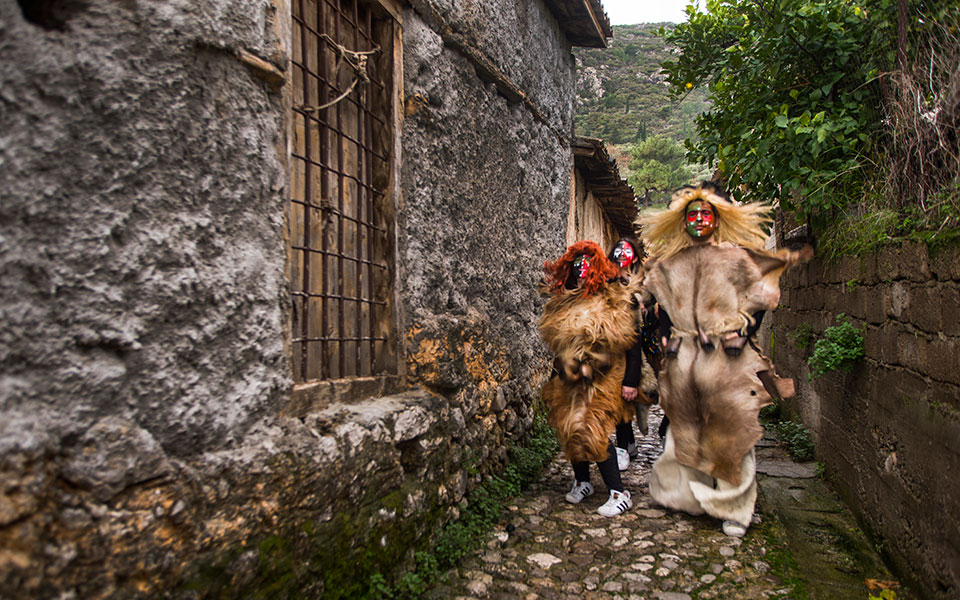
© Clairy Moustafellou
Amfissa
Inhabited since antiquity, as is evidenced by the walls of its acropolis, Amfissa is a great destination for visitors intrigued by the history and evolution of traditions. Homes, shops and cafes have all been preserved to look as they did when they were first erected, and the love of all things retro goes far beyond architecture and interior design. This is one of the few Greek towns that has been characterized in its entirety as an archaeological zone, and the people here are proud of their traditions. Carnival, in February/early March, is a great time to visit. During this time of year, thousands of people, dressed in elaborate costumes featuring leather, bells and ropes, the three elements of the area’s traditional crafts, gather to celebrate a local carnival tradition based on a haunting love story.
Great for: photography

© Shutterstock
Galaxidi
Steeped in the history and elegance of its nautical traditions, this seaside village was listed for preservation in 1978 and is a protected heritage site today. In recent decades it has become a tourist and yachting destination, though it has managed to remain relatively low-key. During most of the year, that is, because this is another place that goes all out for Carnival. On the first day of Lent, known in Greece as Clean Monday, chaos and mayhem reign through the streets of the otherwise quiet village. This is the “alevromoutzouroma,” or “flour war” an old custom of unknown provenance whereby revelers throw colored flour at each other and blacken their faces with coal.
Great for: celebrating apokries (the Greek carnival) in February/early March
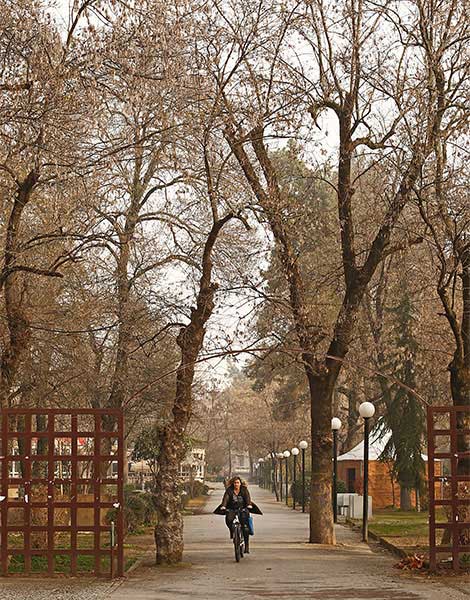
© Nikos Kokkas
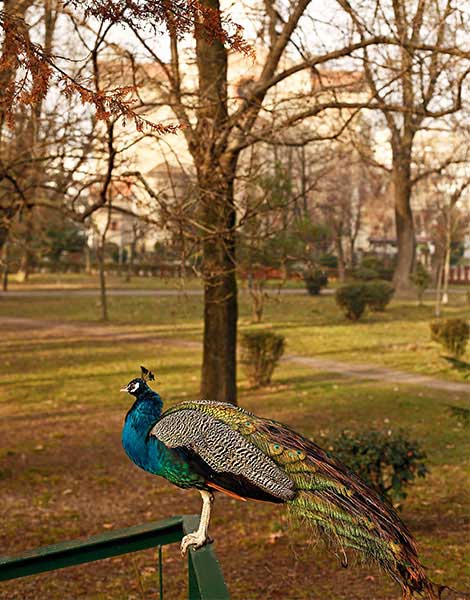
© Nikos Kokkas
Karditsa
Living up to its name, Karditsa is situated in the very heart of Greece (Karditsa literally means little heart), and therefore works as a great starting point for excursions. Nearby cities include Volos, Lake Plastira, Meteora, Larissa and Trikala. Proximity to sights is an advantage within the town as well, as everything is within a stone’s throw, and it’s easy to get around by foot or by bike. Pay a visit to Pafsilypou Park, with its wild peacock family, the Archaeological Museum, where you’ll learn about Neolithic households, as well as the day-to-day lives of people in Thessaly during the Bronze Age, and spend some time at the meze restaurants, which are always full of people sipping tsipouro and playing backgammon.
Great for: short breaks
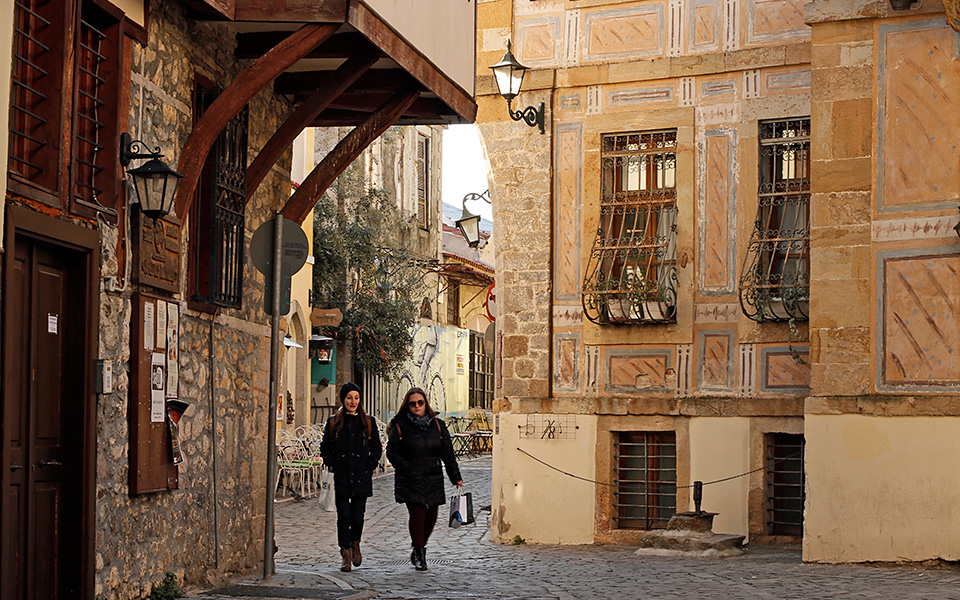
© Nikos Kokkas
Xanthi
The 19th and early 20th c., when the premium Basma tobacco variety began to be widely cultivated here, were Xanthi’s golden years. The profitable product attracted affluent families and workers from many different areas. The city’s economic growth was accompanied by significant cultural and artistic development, and the tobacco merchants built impressive mansions in what’s now known as the Old Town. Today, the mansions are home to everything from museums and art galleries to schools and offices. Xanthi is a great base for the outdoorsy, with the Nestos River, popular for kayaking, rafting and more, just 15km away.
Great for: celebrating apokries (the Greek carnival) in February/early March

© Nikos Kokkas
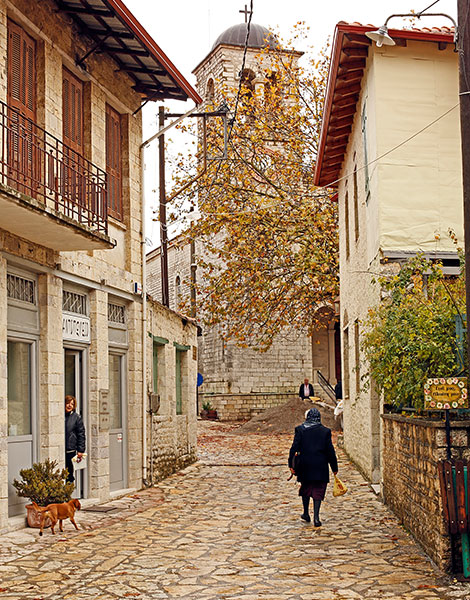
© Nikos Kokkas
Nafpaktia
The mountains of Nafpaktia, in the southwest mainland of Greece, are a popular weekend destination – mainly during the colder months. In the depths of winter, the green hills are hidden beneath a white blanket, and in fall and spring, the steep hiking paths take you by gurgling brooks to fairytale waterfalls in the forest. The village squares, where you’ll find kafeneia (traditional cafes) and shops selling local products, are stone paved and shaded by huge plane trees. However, the accommodations here are of the kind that will also make you feel content with staying inside, as most are beautiful and stone built, featuring fireplaces and cozy common areas.
Great for: curling up with hot beverages
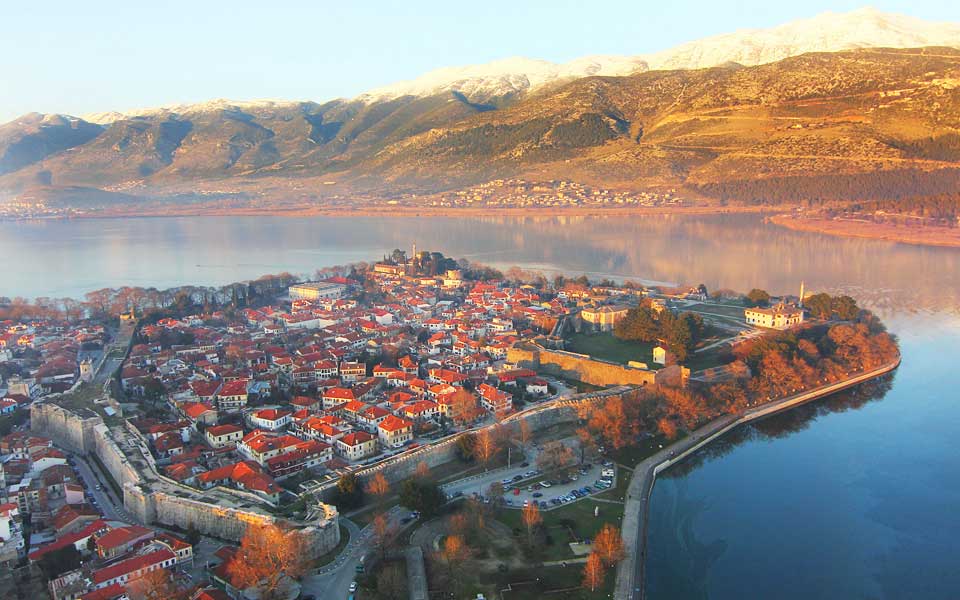
© Xrysostomos Fountas
Ioannina
One of the most enchanting historic cities in Greece, Ioannina is built on the shores of Pamvotida Lake which boasts a gorgeous promenade running by the water’s edge, and old monasteries on an island at its center. While history is traceable everywhere in this city, being a university town with 15.000 students attending each year (a lot in relation to the city’s 65.000 permanent residents), it also has a young and contemporary vibe, boutique hotels and plenty of fun places to dine, drink, and shop. In the winter the fog that often envelops the town leaves impressions that last a lifetime.
Great for: culture lovers
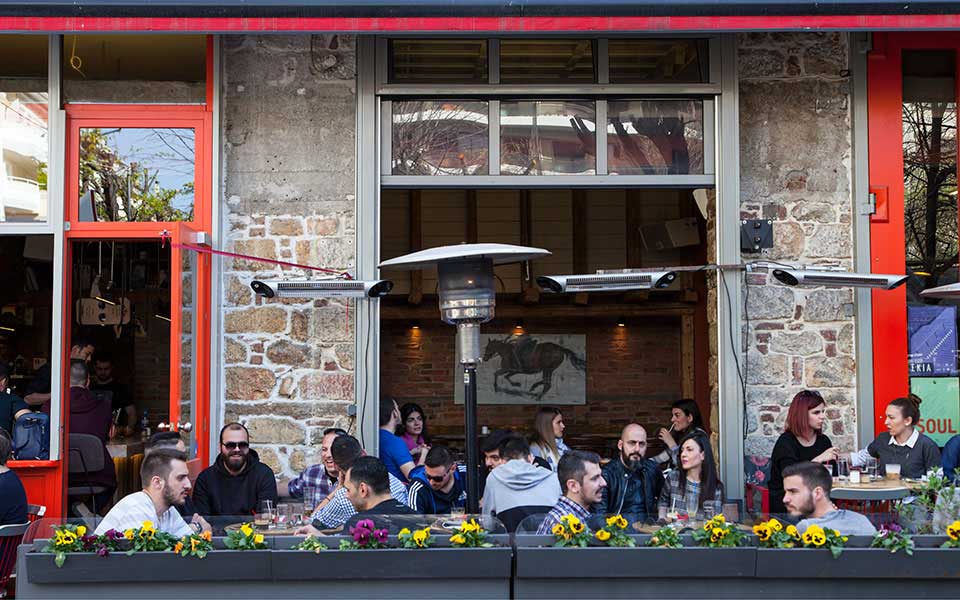
© Olga Charami
Larissa
Located 355km north of Athens (about a 3.5-4-hour drive), Larissa is a natural stop on the way to many more famous destinations around Greece such as Meteora, Mount Olympus, Thessaloniki, or Halkidiki. However, there’s a rather unique reason to visit Larissa that makes it a worthwhile destination all on its own: it’s a coffee lovers paradise. Research indicates that the citizens of this town are the number one coffee consumers in Greece, and as a result, cafes offering specialty coffees (single-origin and with specific harvesting and roasting methods) are rapidly on the rise.
Great for: caffeine addicts

